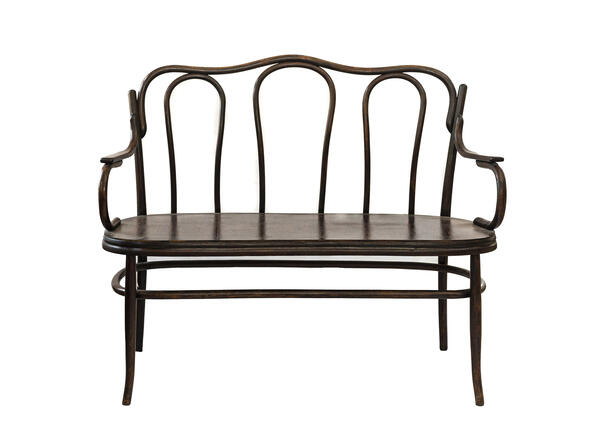The word “divan” (sofa) came into the Russian language from Persian. This was originally the name of documents, then a room with special elevations for seating along the walls. Later the word “divan” began to refer to furniture.
European sofa originated in the 17th century and were a bench connected to a soft upholstered chair. The first sofas in Russia appeared in the middle of the 18th century. Prince Grigory Potemkin brought them into fashion. They were similar to the Turkish ones: wide, with many cushions. These sofas were particularly popular in 19th-century France. They were placed in a special room (it was called “divannaya” (sofa room)), located next to the living room.
The sofa at the exhibition belongs to the so-called “Viennese furniture”, popular at the turn of the 19th-20th centuries, which was invented by the furniture maker Michael Thonet. He was of German descent but moved to Vienna. That is why his products have such a name.
Thonet invented the technology of making wooden pieces of furniture from bentwood, the shape of which could be changed with the help of hot steam. His innovation did not initially resonate in Germany, England, and Russia, but in Vienna, the Austrian chancellor and Emperor were interested in his items.
In 1850, the first batch of 400 identical chairs named “Model No. 1” were sent to the city of Budapest. In addition, in 1859, Teplyakov put his most famous model, No. 14, up for sale. It was a chair consisting of six standard elements twisted by metal screws. The chairs were delivered to the stores, disassembled in 36 pieces in a box, and assembled on site. Such a system significantly reduced the costs of storage and transportation of products.
Thonet’s furniture was not only the lightest and cheapest in the world market but also the most reliable. It was said that the Viennese chair remained intact after falling from the Eiffel Tower. However, soon enough, Thonet ceased to be a monopolist on the Viennese furniture market: numerous competitors launched their productions of identical models.
European sofa originated in the 17th century and were a bench connected to a soft upholstered chair. The first sofas in Russia appeared in the middle of the 18th century. Prince Grigory Potemkin brought them into fashion. They were similar to the Turkish ones: wide, with many cushions. These sofas were particularly popular in 19th-century France. They were placed in a special room (it was called “divannaya” (sofa room)), located next to the living room.
The sofa at the exhibition belongs to the so-called “Viennese furniture”, popular at the turn of the 19th-20th centuries, which was invented by the furniture maker Michael Thonet. He was of German descent but moved to Vienna. That is why his products have such a name.
Thonet invented the technology of making wooden pieces of furniture from bentwood, the shape of which could be changed with the help of hot steam. His innovation did not initially resonate in Germany, England, and Russia, but in Vienna, the Austrian chancellor and Emperor were interested in his items.
In 1850, the first batch of 400 identical chairs named “Model No. 1” were sent to the city of Budapest. In addition, in 1859, Teplyakov put his most famous model, No. 14, up for sale. It was a chair consisting of six standard elements twisted by metal screws. The chairs were delivered to the stores, disassembled in 36 pieces in a box, and assembled on site. Such a system significantly reduced the costs of storage and transportation of products.
Thonet’s furniture was not only the lightest and cheapest in the world market but also the most reliable. It was said that the Viennese chair remained intact after falling from the Eiffel Tower. However, soon enough, Thonet ceased to be a monopolist on the Viennese furniture market: numerous competitors launched their productions of identical models.



